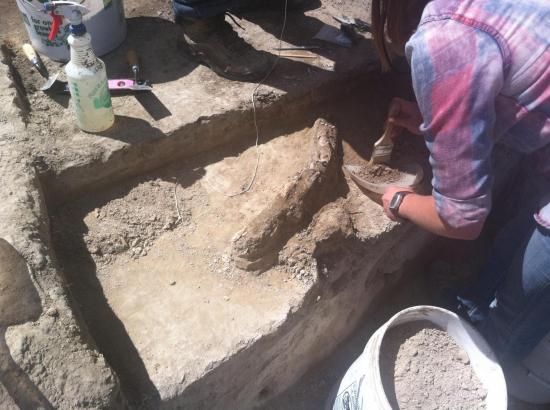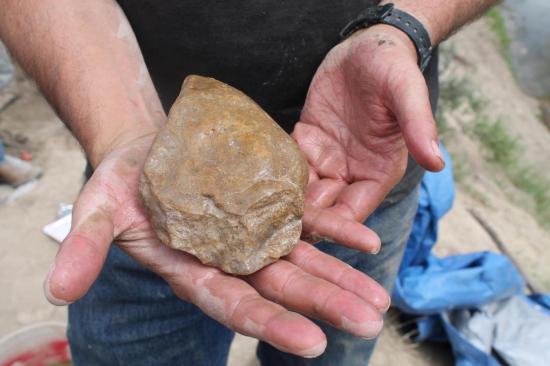Melodie Edwards
Source - http://wyomingpublicmedia.org/post/rare-mammoth-site-excavated-douglas

Mammoth Rib Bone. Melodie Edwards
In 1986, a large mammoth rib bone was found jutting out of the bank of a creek a few miles from Douglas. The state archaeologist, Dr. George Frison, did a hasty 4-day excavation at the time. But a thorough excavation has never been done because the land owners weren’t interested in hosting an archaeology dig on their property. That left archaeologists with a big question--was LaPrele Creek a mammoth kill site? But recently the land sold and archaeologists have finally been allowed to dig.
Under the hot sun next to LaPrele Creek, UW anthropology professor Todd Surovell and several of his field school students are hunched over a curved mound protruding from the ground. It’s the size and shape of a French baguette, and it’s the rib of an ice age mammoth. They’re getting the bone ready to remove. Very carefully
“What I’m thinking we’ll do is remove it as a block,” Surovell says. “So we’ll wrap the whole thing in plaster. And then take it out as one big piece.”
Surovell says to prove it’s a kill site, they need to find human stone tools. Colorado State anthropology professor Richard Adams believes he did just that.
“It was purely a fortuitous discovery,” Adams says. “I was enlarging the trail to make it safer for people with buckets and, ting! Hit it with a shovel.”
It was a stone chopper. Probably a heavy-duty butchery tool. And two large stone tools—called cobbles—were also found in the dig. But UW anthropology professor Robert Kelly—who is co-teaching the field school with Surovell—isn’t so sure.
“I’ve changed my mind each day that we’ve been here. So today I’m thinking there was some human involvement with this particular mammoth.”
“But if I come and ask you this question tomorrow?” I ask.
“Who knows,” Kelly says, laughing.
Kelly says the reason mammoth kill sites are so exciting and rare is because they tell us so much about the Paleo-Indian people who managed to use stone tools to bring down a ten-ton elephant.

Chopper Tool In Situ. Melodie Edwards

Chopper Tool with signs of human working.Melodie Edwards
“There was probably a great deal of stealth,” he says. “A lot of skill in knowing exactly where you’re going to have to hit an elephant in order to kill it. It almost certainly would have been a group endeavor because you’re going to have to hit it multiple times in order to kill it. It would not have been easy.”
There are also other, even harder questions that the scientists in the dig are exploring. 88-year-old geo-archaeologist Dr. Vance Haynes is one of the world’s foremost authorities on mammoth digs. And for many years has been trying to uncover the mystery of how they became extinct.
“There’s no camel, no horse,” he says. “There’s bison. Bison survived. Probably because there was so many of them that natural selection left some. Whatever caused the extinction, which that’s the 64-dollar question.”
Robert Kelly says kill sites like this one can help answer those questions. He says it’s hard to know whether humans wiped out the mammoths or whether it was natural climate change.
“The large animals like mammoths, some archaeologists think that they were a focus of subsistence. Others figure that they might have killed one mammoth in their lifetime and never stopped talking about it.”
The crew probably won’t solve the big mysteries of the ice age this summer. But Kelly and Surovell both agree that enough evidence of human activity has been found during this dig to warrant another dig next year.